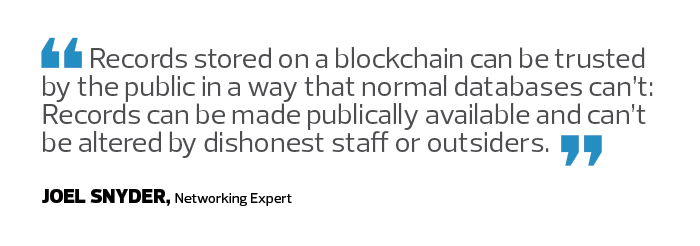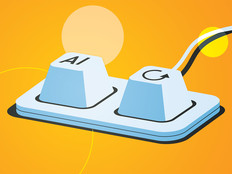Fact or Fallacy: Can Government Blockchain Live Up to the Hype?
Network managers can’t avoid hearing questions about bitcoin from friends and relatives. But hidden amid all the financial speculation remains an interesting technology: blockchain.
The hype cycle is extraordinarily high with blockchain technology right now, and that will likely continue for some time as entrepreneurs and innovators try to cash in on the news surrounding cryptocurrencies and blockchains. But the mere presence of hype doesn’t mean there’s nothing to blockchain, or that network managers won’t be using it in their applications very soon.
Here are some facts and fallacies that state and local government IT managers should keep in mind:
Fallacy: States and Localities Should Start Accepting Bitcoin as a Payment Method
Bitcoin, and most other cryptocurrencies, are not useful as currencies because they don’t act like traditional currencies. With the cost of bitcoin shooting up and down every day, prudent CFOs will refuse to hold it. Fees, while independent of value (unlike credit cards), are also disproportionately high for small transactions — a second strike.
Agencies that start to accept bitcoin — perhaps for the public relations value more than anything else — won’t touch it anyway. Payments will arrive via a payment processor that immediately converts the currency to dollars (and is responsible for security, privacy and compliance issues), in the same way that credit card transactions are processed.
Fallacy: Cryptocurrencies Are the Only Use for Blockchain
Bitcoin is an application that runs on a blockchain — a type of distributed database managed in a decentralized way — and cryptocurrencies such as bitcoin are just one way to use it.
Blockchains are based on existing, well-understood technologies such as public/private key cryptography, hashing and peer-to-peer networks. That doesn’t make blockchain any less innovative, but it gives IT professionals more confidence in its underlying security.

One major value of a blockchain is that it allows a permanent, unvarying record of transactions, whether financial or for something more prosaic, such as property deeds. The record can grow with new transactions, but old ones cannot be edited or deleted. For government IT professionals, that is a very useful type of database, and very different from traditional tools such as SQL databases. Records stored on a blockchain can be trusted by the public in a way that normal databases can’t, because they can be made publicly available and can’t be altered by dishonest staff or outsiders.
Fact: Blockchain Will Be in Data Centers Soon
Innovators have proposed blockchain technology for virtually everything that runs in a data center, from logging systems to authentication databases.
Few of those ideas will stand up to strict scrutiny, and SQL and NoSQL databases are not going away anytime soon.
While blockchain does provide services that overlap some database applications, it fits a more narrow and restrictive niche. Applications that call for a widely distributed database — where transaction integrity is critical and high performance is not — may find good use for the blockchain.
For example, many municipalities collect tax payments over a long period of time. As government systems and owners change over time, the ability to prove that someone made a particular payment many years ago can be critical.
Blockchain technology can be used to publish a ledger of payments, ensuring easy verification and a long-term record that will not be easily lost or corrupted.
Fallacy: Blockchains Can’t be Hacked
The blockchain is a distributed database with multiple replicas throughout the network, so there are two major potential vulnerabilities: One is the cryptographic hash algorithms that hold everything together, and the second is the network of database maintainers itself.
The hash algorithms are chosen from trusted, publicly developed cryptographic algorithms that IT professionals are already familiar with, such as SHA-256 and RIPEMD-160. Any blockchain can choose its own algorithms, but those two are the most popular.
By selecting well-known, tested and studied cryptography for a blockchain application, the risk of a failure is minimized. There is still a potential for vulnerability here, just not one that anyone has exploited yet.
A more subtle way of hacking the blockchain comes by taking over a majority of the systems committing the transactions to the blockchain, the so-called “miners.”
When a public blockchain is used for an application, only a minimum of trust is required between peers in the public network; however, if a bad actor controlled a majority of the miners, then they could subvert the intention of the network. In large networks, such as that supporting bitcoin, that is nearly impossible. Where an entity runs its own smaller blockchain network for a particular application, it’s important to ensure that the majority of the nodes mining on the blockchain are trusted to play by the rules.
Still, the distributed nature of blockchain allows users to guard against too much power concentrated in too few hands by ensuring that no single actor controls the majority of the nodes in the network. For example, a government blockchain database application should be distributed among multiple affiliates by independent agencies, thereby guarding against a rogue IT administrator at any one agency.
It's not all hype, check out how New York and Illinois are experimenting with blockchain in government.









